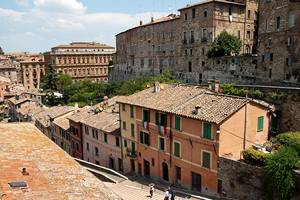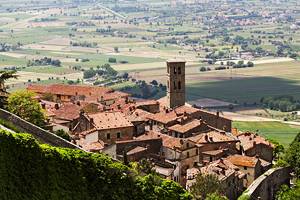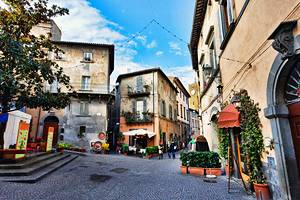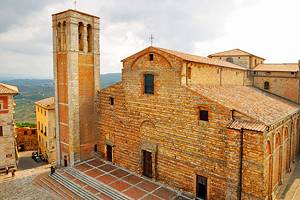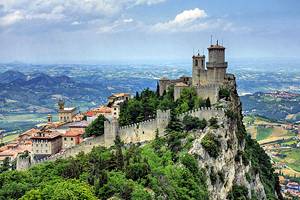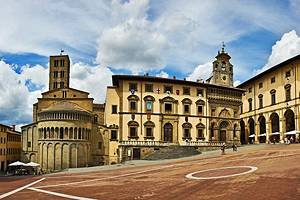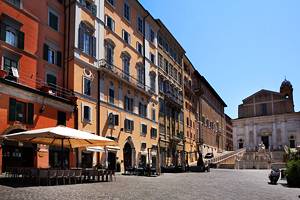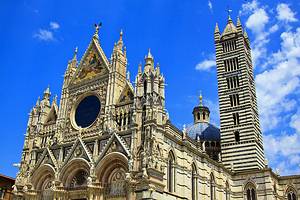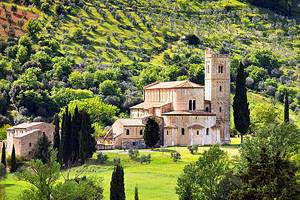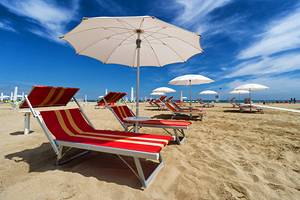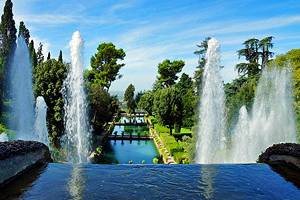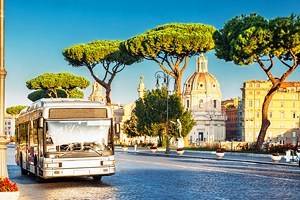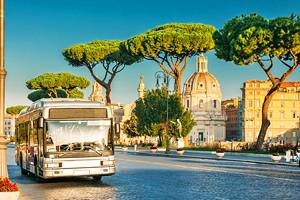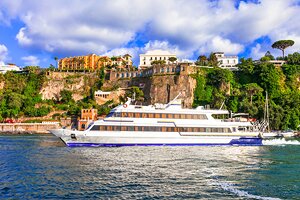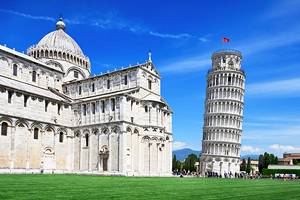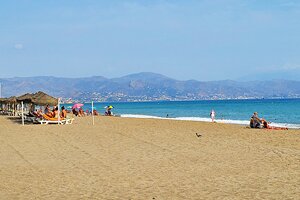15 Top-Rated Attractions & Things to Do in Assisi
When UNESCO inscribed the Franciscan attractions in Assisi on the list of World Heritage Sites, it cited the way in which the city influenced both religious expression and Europe's art history. It is the intertwining of these two features that make this medieval town an important landmark for tourists.
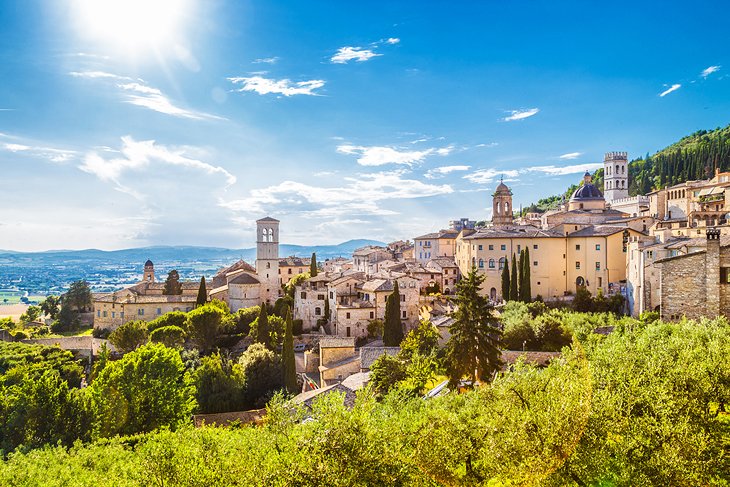
As the birthplace of St. Francis, and the center of much of his life's work, it is entwined with the Franciscan order, which he established. His life and work inspired great artists - Giotto, Cimabue, Andrea da Bologna, and Simone Martini among them - and their works in the basilica dedicated to him have told his life story to the faithful for eight centuries. But amid the treasury of art that Assisi holds, don't overlook its atmospheric medieval streets and the outstanding castle atop this Umbrian hill town.
The main Via San Francesco leads from the basilica into the center, changing its name to Via Arnaldo Fortini. If you're interested in shopping, you'll find plenty of opportunities here. Assisi, like Florence, is known for its leather work. Learn about the best places to visit in this charming town with our list of the top attractions and things to do in Assisi.
See also: Where to Stay in Assisi
- 1. Basilica di San Francesco (St. Francis Basilica)
- 2. Santa Maria degli Angeli
- 3. Cathedral of San Rufino
- 4. Santa Chiara
- 5. Le Carceri and Monte Subasio
- 6. Convento di San Damiano
- 7. Rocca Maggiore
- 8. Roman Forum and Museum
- 9. Piazza del Comune and Palazzo del Capitano del Popolo
- 10. Tempio di Minerva (Temple of Minerva)
- 11. Santuario di Rivotorto
- 12. Chiesa Nuova
- 13. See Assisi from the Air: Paragliding
- 14. Franciscan Friary and San Pietro
- 15. Pinacoteca Comunale (Municipal Art Gallery)
- Where to Stay in Assisi for Sightseeing
- Tips and Tours: How to Make the Most of Your Visit to Assisi
1. Basilica di San Francesco (St. Francis Basilica)
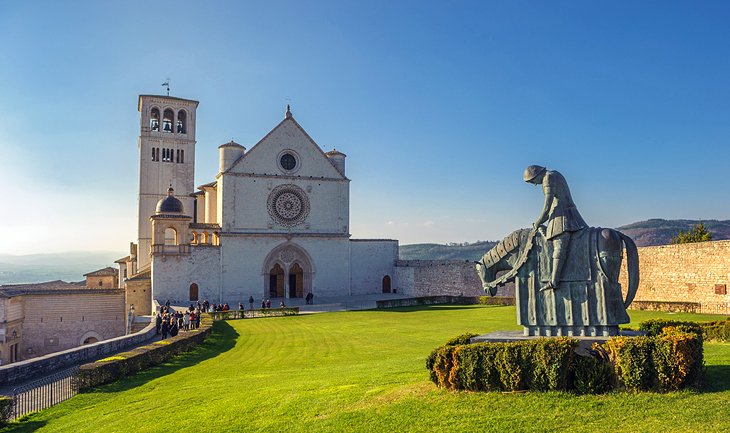
The impressive basilica built over the tomb of St. Francis of Assisi in the early 13th century is one of Italy's - and the world's - most important pilgrimage destinations. Pope Gregory IX laid the first stone the day after St. Francis was canonized, on July 17, 1228.
It is really two churches: the lower one with heavy Late Romanesque vaulting and the upper one with the same floor plan, but soaring vertical Gothic lines. Completed in 1253, it is the oldest Gothic church in Italy. The basilica suffered extensive earthquake damage in 1997 and was not re-opened until 1999, but the damage was confined to the upper church.
Both churches are decorated with beautiful frescoes from the 13th and 14th centuries. In the first chapel of the lower church are remarkable scenes from the life of St. Francis by Giotto and Simone Martini. In the lower transept, the chapel of St. Catherine of Alexandria is decorated with 14th-century frescoes by Andrea da Bologna, and the cycle in the nave was painted about 1260 by an unnamed artist known only as the Maestro di San Francesco.
Despite centuries of deterioration, these are the most important Tuscan frescoes prior to Cimabue. In the choir of the upper church and in the transepts are frescoes by Cimabue, and in the nave are 28 scenes from the life of St. Francis ascribed to Giotto and his students.
Unfortunately, these were seriously damaged in the earthquake. In the crypt, you'll find a stone sarcophagus containing the saint's remains, brought here during construction and lost until their discovery in the 19th century.
Address: Piazza San Francesco, Assisi
Official site: www.sanfrancescoassisi.org
2. Santa Maria degli Angeli
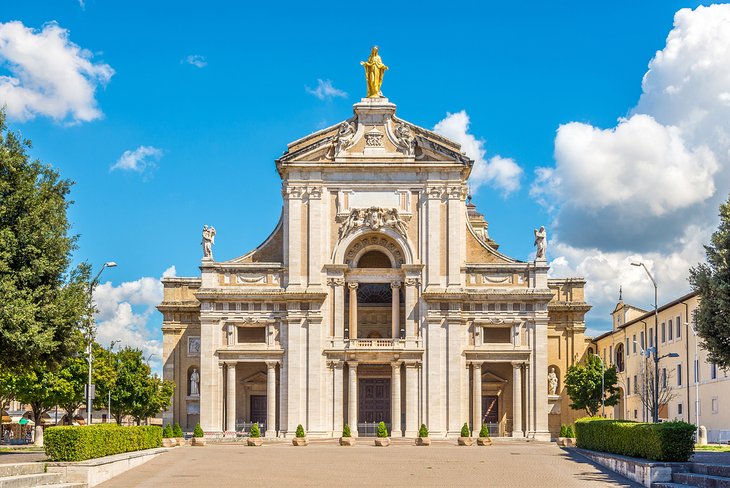
About four kilometers west of Assisi, in the small village of Santa Maria degli Angeli, is the massive domed Renaissance church of Santa Maria degli Angeli. It was built between 1569 and 1630 over St. Francis' oratory (Porziuàncola) and the cell in which he died.
The nave and choir were re-erected after the earthquake in 1832, and a new façade was added in 1925-28. To the east of the sacristy is a small garden where the roses are believed to have been thornless since an act of penance by the saint.
3. Cathedral of San Rufino
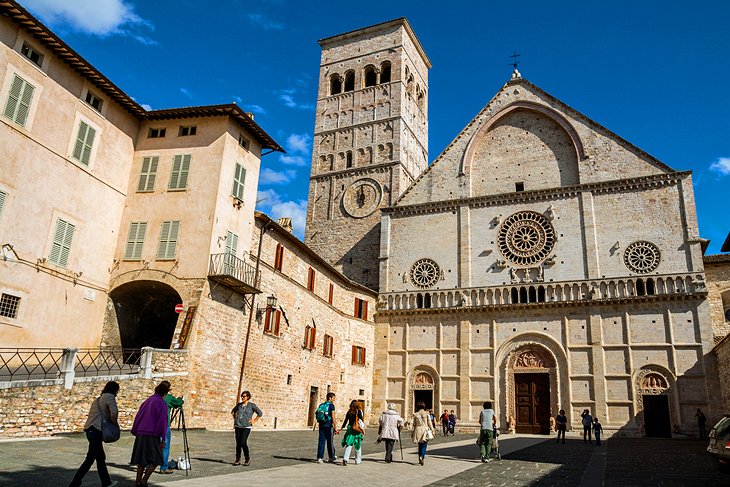
Adjacent is the Cappella delle Rose with fine frescoes by Tiberio d'Assisi, from 1518, depicting scenes from the saint's life. For walkers, the sanctuary makes a nice half-day outing, or it can be combined in a circular driving route with a visit to Rivolato, another pilgrimage site connected to St. Francis.
Built in the 12th and 13th centuries, the cathedral of San Rufino has wonderful examples of early medieval stone carving. Animals form corbels, mythical beasts climb pilasters, delicate foliage entwines capitals, saints and their symbols guard doorways. St. Francis prayed in its crypt, which dates from the 11th century, when he came to preach at the church.
Today, this crypt is an atmospheric place, with three aisles and an apse, where you'll find an outstanding third-century Roman sarcophagus carved in marble. In the cloisters is a Roman well. Many of the cathedral's treasures, both historical and artistic and including Roman finds from the cathedral area, are housed in the museum.
The multi-paneled canvas Madonna of the Rosary, painted in 1581 by Lorenzo Doni, 13th-century frescoes telling the story of Christ, a beautiful polyptych of San Rufino from 1462, and a second-century Roman sarcophagus are among the highlights, along with paintings by Jacopo della Quercia and Filippo Lippi.
Address: Piazza San Rufino 3, Assisi
4. Santa Chiara
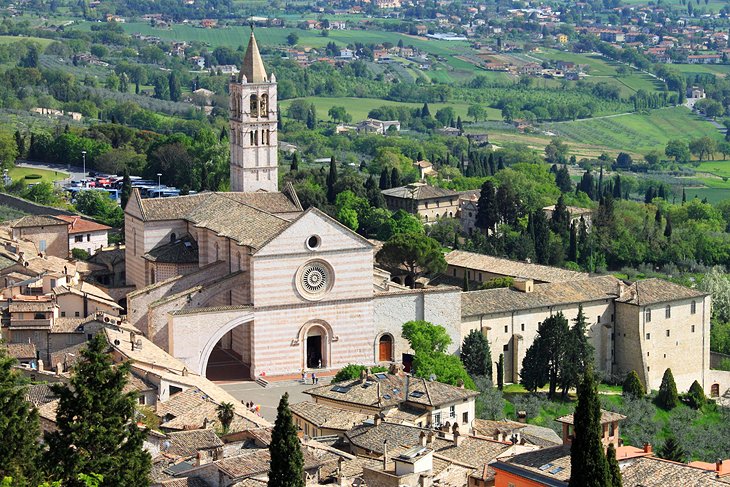
The Gothic basilica dedicated to St. Clare was built in 1265 to honor the enthusiastic disciple of St. Francis who founded the order of Clarissines or Poor Clares. Under the high altar is the open tomb of St. Clare, who died in 1253.
In the Cappella del Crocefisso, on the left side of the nave, hangs the Speaking Cross from the convent of San Damiano, in front of which St. Francis is said to have received the message from God to "go forth and rebuild my house." The interior is painted with a cycle of frescoes of the life of St. Clare by various artists. From the attractive Piazza Santa Chiara in front of the church is a beautiful view across the valley.
Address: Piazza Santa Chiara, Assisi
5. Le Carceri and Monte Subasio
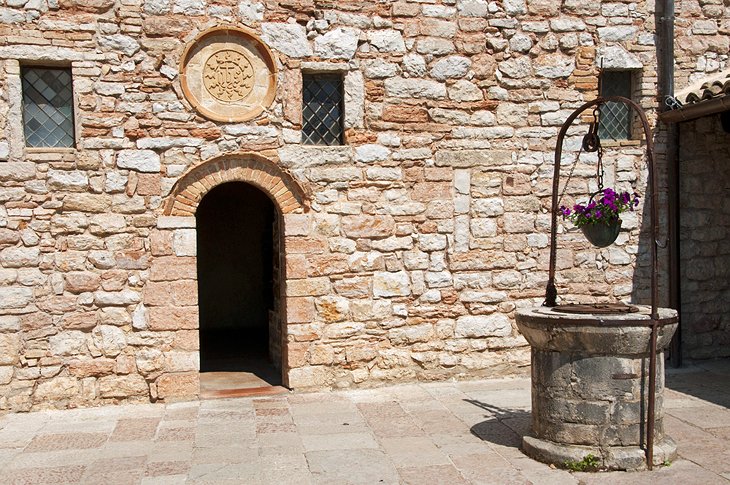
In a charming location east of Assisi, in a small wood of holm-oaks above a ravine between the bare rock faces of Monte Subasio, is the hermitage of Le Carceri where St. Francis retired for his devotions. These were originally caves, but between the 15th and early 19th centuries, a small monastery gradually grew at the saint's grotto. You can see his rock-bed here.
From the monastery, it's an hour-and-a-half climb to the broad ridge of Monte Subasio, at an altitude of 1,290 meters, with panoramic views. Within easy driving distance on the other side of Monte Subasio is Spoleto, famous for the music festival that originated there.
6. Convento di San Damiano
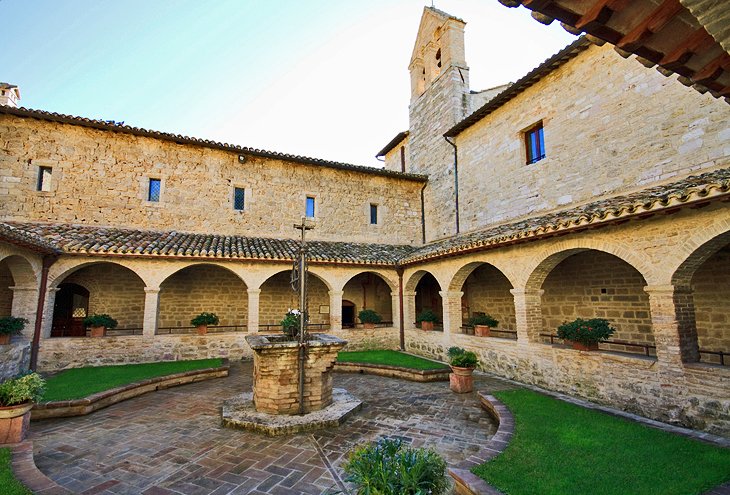
Southeast of the town center is the little convent of San Damiano, founded by St. Francis. St. Clare was the first abbess, and died here in 1253; she was canonized two years later. San Damiano is where St. Francis is believed to have received the message from God to "go forth and rebuild my house," a command he took literally by rebuilding the little church with his own hands.
It was a favorite retreat for St. Francis and his followers, and on the small flower-filled terrace in front of the convent, he is said to have composed his famous Canticle of the Sun. You can visit the church, the cloister with early 16th-century frescoes by Eusebio di San Giorgio, the convent, and the convent gardens.
The San Damiano complex is part of the site inscribed by UNESCO as "essential for the understanding of the religious awakening of St. Francis, as well as being the convent of St. Clare."
Address: Via San Damiano 85, Assisi
7. Rocca Maggiore
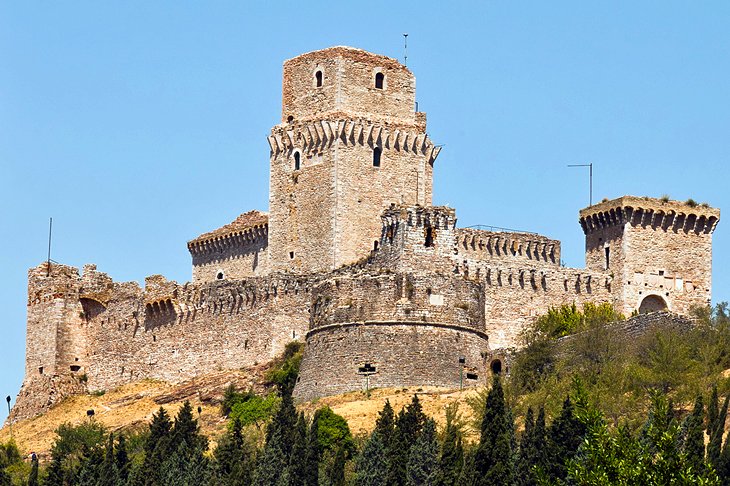
From the Piazza di San Rufino, the old Via Santa Maria delle Rose ascends to the Rocca Maggiore, a picture-perfect castle high above the town. Originally one of several fortresses built along the town walls, it was re-built by Cardinal Albornoz in 1365.
Emperor Frederick II sometimes stayed here when he was young. The castle is a good one to explore, as you can get a good picture of building techniques, as well as panoramic views. A long wall extending from the main part of the castle ends in a tower, intended as a watch post, which you can climb for views.
A tunnel connects the tower and castle, and walkways along the top of the wall are recessed for protection. The walls surround a large green that once held gardens to supply the castle in case of siege. Inside, figures are dressed in costumes showing clothing typical of 14th-century nobility.
Address: Via della Rocca, Assisi
8. Roman Forum and Museum
A relatively new attraction in Assisi is the excavated Roman Forum and other remains underneath Piazza del Comune. The entrance is through the Romanesque crypt of a church and a passageway that is the ancient Roman street. In both these areas, Roman capitals, sarcophagi and other ancient artifacts are displayed.
Among the excavations are the base of the temple, a large cistern, fountains, statues, and a dias for the tribunal with seats for the magistrates. The excavations and artifacts are enhanced by video presentations.
Address: Via Portica, Asssisi
9. Piazza del Comune and Palazzo del Capitano del Popolo
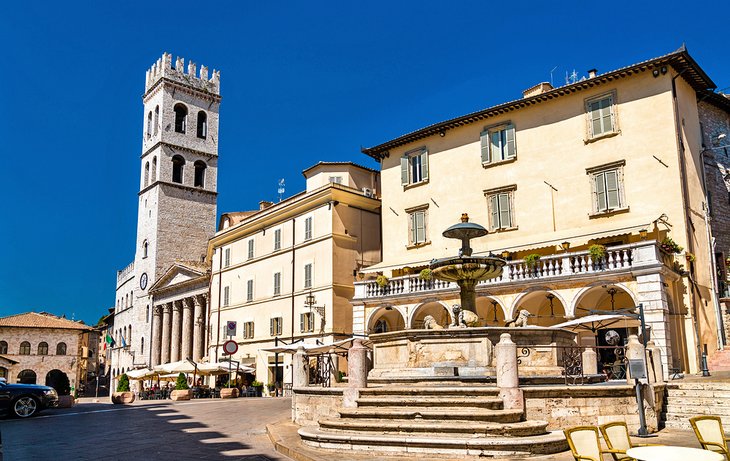
Piazza del Comune is the town's main square, as it was in Roman times when it was the forum (you can explore the archeological site underneath the Piazza - see the attraction above). Along one side of the piazza are the Tempio di Minerva and the 47-meter-tall tower, Torre del Popolo, built in 1303.
The tower was built to house the family of the Capitano del Popolo - the Captain of the People - whose residence was the Palazzo del Capitano del Popolo. That building, which was also the seat of local government, dates to the second half of the 13th century. It was heavily renovated in 1926, when the interior was decorated with paintings representing medieval trades.
At one end of the Piazza del Comune is a fountain with stone lions. The piazza is still at the heart of local life, and you'll find shops and places to eat in the streets surrounding it.
10. Tempio di Minerva (Temple of Minerva)
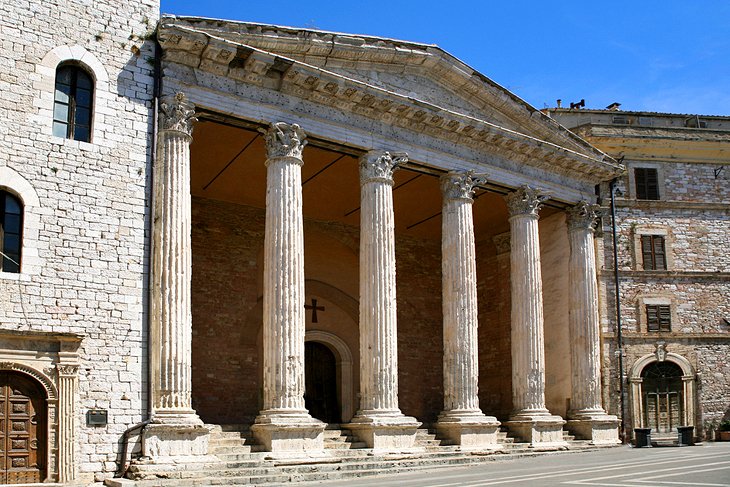
The portico of the Temple of Minerva dates from the first century BC and was converted into the church of Santa Maria della Minerva in 1539. It was renovated in the 17th century in the Baroque style, but the façade is still the original Roman columns and architrave.
A fresco of Giotto's in the Basilica of St. Francis shows the building with bars on the windows, leading historians to believe that it was used as a jail in medieval times.
Address: Piazza del Comune, Assisi
11. Santuario di Rivotorto
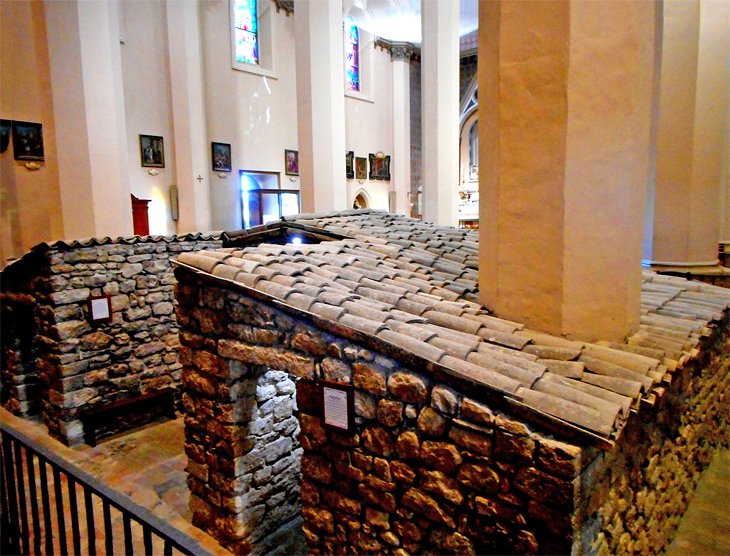
About five kilometers south of the town center is the site of the first Franciscan community, where you can see the crude stone shelters where the first followers lived and worshiped in the early 1200s. The sanctuary church is built over the original dwellings, where you can see the table used by St. Clare and other artifacts of their time.
The humble and primitive surroundings underscore the principles of poverty and simplicity embraced by St. Francis and his followers. If you walk from Assisi, check the opening times, as the church is part of an active Franciscan community and only open limited hours.
12. Chiesa Nuova
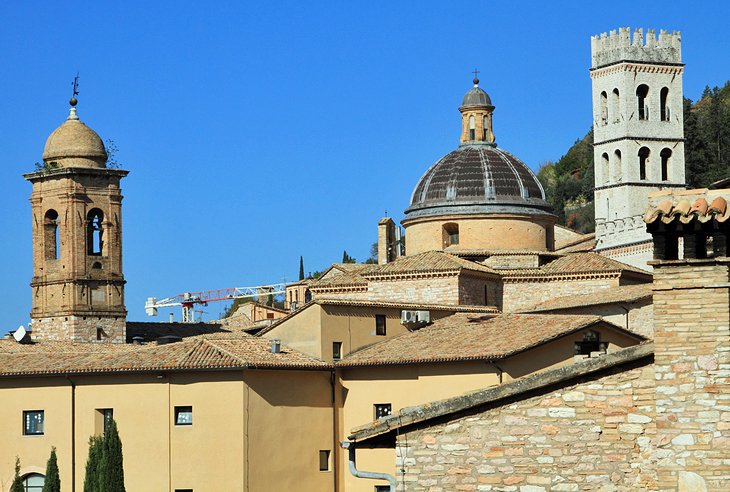
A little way south of the Palazzo Comunale, on a lower level, is the Chiesa Nuova (1615), a small church on a centralized plan, erected on what was thought to be the site of St. Francis's birth. Visiting Assisi in 1613, the Spanish Vicar General of the Franciscans saw the dilapidated condition of the house of Pietro di Bernardone, believed to be the birthplace of St. Francis.
With a gift by King Philip III of Spain, he was able to buy the house, and the church was built with its high altar over what was considered to be St. Francis's room. The late Renaissance-style church is decorated with 17th-century frescoes by Cesare Sermei and Giacomo Giorgetti. There is a small museum in the adjoining friary.
13. See Assisi from the Air: Paragliding
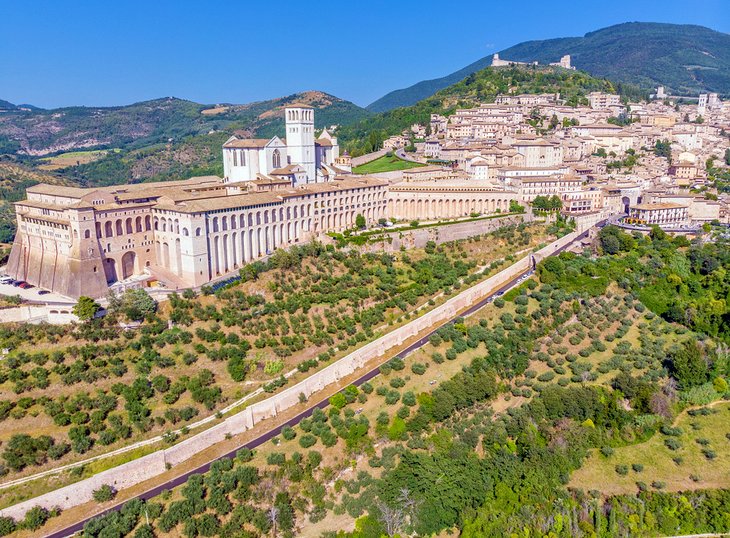
You can more fully appreciate the size and grandeur of the Basilica of St. Francis with a bird's-eye view, and nowhere else can you see it in almost complete silence, far above the crowds of pilgrims and tourists below. On a Paragliding for two over the skies of Assisi adventure, you and a companion will glide high above the city of Assisi and the Monte Subasio park for unparalleled views of the Umbrian countryside and the town's tiled rooftops and stone towers.
Enjoy the freedom of gliding through the air with an experienced instructor/pilot behind you guiding your flight. All the equipment is provided, even a Go-pro for photos and videos as souvenirs of your paragliding adventure.
14. Franciscan Friary and San Pietro
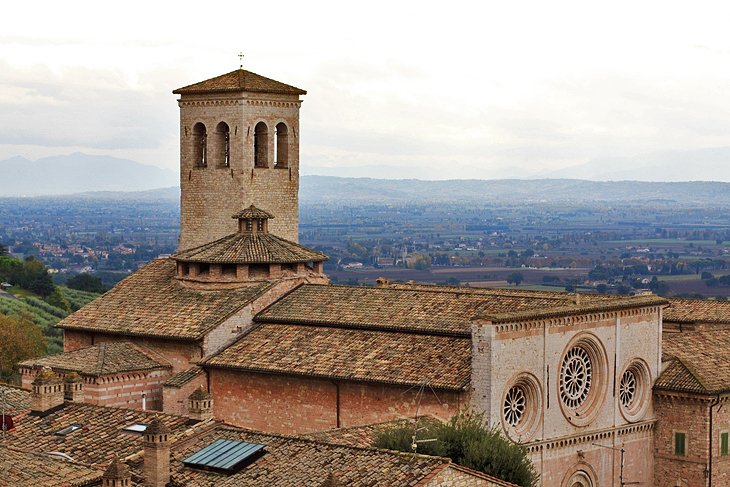
On the edge of the hill to the northwest rises the Franciscan friary begun soon after the saint's death. It was already occupied by the friars in 1230, but completion of such a large set of buildings took so long that different styles had become popular. The resulting complex, built with pink and white stone from nearby Mount Subasio, blends Romanesque with Gothic.
The Romanesque campanile was completed in 1239, and the courtyard and external passage, from which there are magnificent views, were renewed by Pope Sixtus IV between 1471 and 1484. The friary has a museum of art donated by centuries of pilgrims.
South of the friary, beyond the Porta San Francesco, stands the church of San Pietro, with a fine doorway and three delicate rose windows. Its austere nave is divided into three aisles by massive columns. Built as a Benedictine abbey some time before 1029, it adopted the Cluny reform in the mid-12th century and later passed to the Cistercians.
15. Pinacoteca Comunale (Municipal Art Gallery)
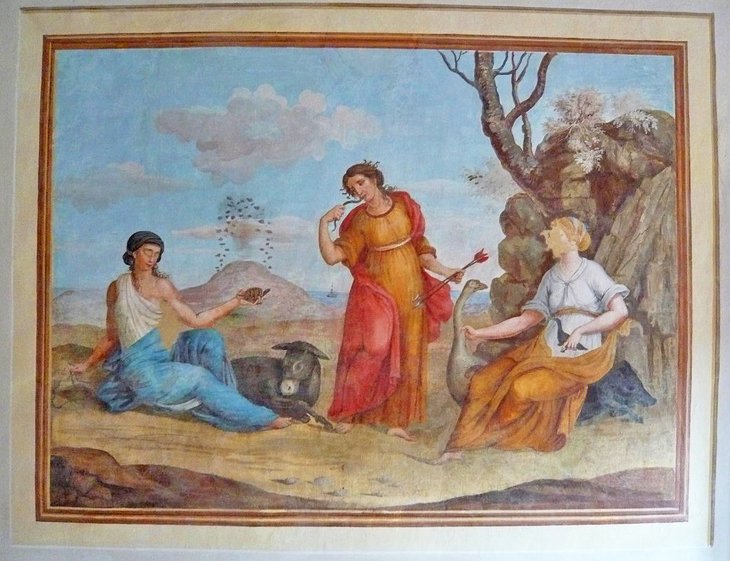
Palazzo Vallemani houses the town's art collection, much of it from decommissioned Assisi churches and convents. The collections include a large group of medieval and Renaissance frescoes and paintings on wood panels and canvas dating from the 14th to 17th centuries.
The most important works are a Maestà (Majesty) attributed to Giotto, as well as paintings by Pietro Perugino, Puccio Capanna, Ottaviano Nelli, Andrea d'Assisi, and Nicolò di Liberatore. A collection entitled "Museum of Memory, Assisi 1943-1944" tells the story of 300 Jews saved from the Nazis by Franciscans.
Address: Via San Francesco 10, Assisi
Where to Stay in Assisi for Sightseeing
We recommend these charming hotels in Assisi close to top attractions and places to see in the old town.
- The 5-star luxury Nun Assisi Relais & Spa Museum is set in a medieval stone monastery, modernized with a white décor, a stylish spa, and an indoor pool.
- The family-run, 3-star Hotel La Terrazza & SPA has a lovely outdoor pool, valley views, and a relaxing spa.
- Only a few steps from St. Francis Basilica, the budget-friendly Hotel Sorella Luna occupies a historic building; in good weather, guests can enjoy the included breakfast on the terrace overlooking a picturesque lane leading to the Basilica of San Francesco.
- The budget Hotel Porta Nuova is in an excellent location with bucolic views. Guests appreciate the hotel's helpful staff.
Tips and Tours: How to Make the Most of Your Visit to Assisi
- Walking Tour: On a three-hour Small Group Tour of Assisi, a knowledgeable local guide will relate the history and importance of the Basilica of Saint Francis of Assisi and the other sites related to the saint and to St. Clare, whose basilica is another important pilgrimage site. After visiting these, your walking tour of Assisi will continue to the sights of Piazza del Comune, the cathedral, and views of the 14th-century Rocca Maggiore fortress.
- Touring Assisi from Florence: Combine a visit to Assisi with two highlights of Tuscany on a full-day Perugia Assisi and Cortona from Florence tour. With your local guide, you will visit the highlights of each of these towns and discover their Etruscan, Roman, Gothic, and Renaissance artworks, along with Assisi's important pilgrimage sites. Between stops in these towns, you can appreciate the beautiful Tuscan countryside from the comfort of your air-conditioned coach.
- Touring Assisi from Rome: Spend a day in the lovely Tuscan countryside on an Assisi and Orvieto Day Trip from Rome, combining the two hilltop towns into one attraction-packed day. Highlights include the Gothic masterpiece, Orvieto Cathedral; lunch near the shores of lovely Lake Trasimeno; and visits to three major historic and pilgrimage sites in Assisi: the Basilica of San Francis, the Basilica of Santa Chiara, and the Sactuary of Santa Maria degli Angeli.
More Related Articles on PlanetWare.com
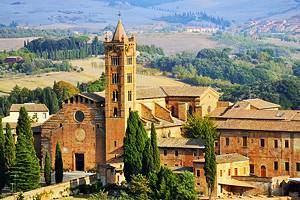
Discovering Umbria and Southern Tuscany: When you're in Assisi, it's a good time to explore two other fascinating towns in Umbria, which you can do with the help of two handy PlanetWare guides: Top-Rated Tourist Attractions in Orvieto and Top Tourist Attractions in Perugia & Easy Day Trips. To the northwest, in Tuscany, you can visit the tourist attractions in Siena and the hilltop town of Montepulciano.

Where to Go Next: The Adriatic coast is only a two-hour drive east, where the former Roman seaport of Ancona is now the departure port for ferries to Croatia and Greece. Traveling southward, it's only a two-hour train ride to Rome and the treasures of Vatican City.




